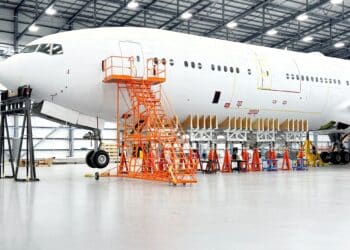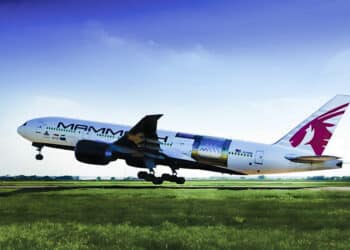BAe floats launch of Avro RJ freighter conversion program

BAe Systems Regional Aircraft put out an interesting press release yesterday, the gist of which is that the company is “considering” a passenger-to-freighter conversion program for the Avro regional jet family.
Those not familiar with the Avro RJ could be excused for thinking the aircraft shown in the image at right was a BAe146 freighter – the quad-jet “Quiet Trader” that has been a familiar sight at European airports for more than a decade in TNT livery. And indeed, the resemblance is more than coincidental, as the Avro Regional Jet was BAe’s successor to the 146 – a newer version of the same family.
With retirement looming for many of the seventy-two RJ100s built, BAe Systems is pushing for a freighter conversion program. The company says it will not offer the program itself, although it “has spent the past year assessing the suitability of the newer-build Avro RJ as a freighter. This work has created a full OEM-designed specification for the freighter which is now being offered to the market.”
So who will offer the program? That is unclear. According to the press release, “BAE Systems will have a strategic MRO partner who will provide the freighter conversion or working party support solution to suit any need.” What is clear is that BAe Systems has gone as far as it is willing to go in terms of investment in the program. A company spokesperson, quoted in The Loadstar, said: “It is not our intention to fund the program beyond what already has been committed. We would require interested parties to commit to the program by way of non-refundable deposits to initiate a full industrial program.”

Technical specifications only tell part of the story, though. The big question with any new P-to-F conversion program is: Who is the customer? Who will want to buy and operate the RJ100F?
When looking at a completely new program, an answer is often hard to find. Until the program is underway, and customers have signed up (or not signed up), one can only speculate. Consider the CRJ200 P-to-F program launched not so long ago by Aeronautical Engineers, Inc. When AEI announced the program, many in the industry doubted that customers would buy a jet freighter that, in many respects, offered similar capabilities to the large turboprop freighters available. However, with AEI about to redeliver the first freighter-converted CRJ200, it has over forty firm orders.
But, the RJ100 is not a radical new departure. Rather, it is a newer, more capable version of the well-known BAe146 – for which the conversion program got off to a strong start, and then stalled. The 30-odd BAe146 aircraft that were converted to large-door freighter configuration are now being retired, and BAe’s attempt to revive interest in the program two years ago met with little success. Will the RJ100 succeed based on the fact that it is newer and more capable? Will fueling and maintaining four jet engines scare potential customers away? Will the RJ100’s rough-field capability find it a profitable niche?
We don’t claim to know the answer, but if you are interested in the RJ100’s chances in a crowded narrowbody conversion market, join us at the Cargo Facts Symposium in Miami 10 – 12 October, where senior executives from major conversion houses and lessors will participate in a session devoted to the freighter conversion market. To register, or for more information, go to www.cargofactssymposium.com.




